Mayday Over Wichita (7 page)
Read Mayday Over Wichita Online
Authors: D. W. Carter

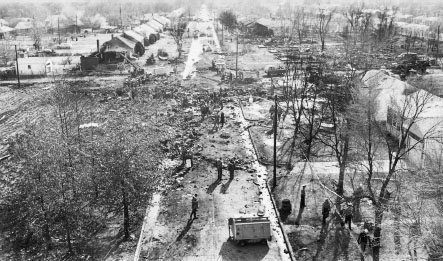
Aerial photo of crater.
Wichita-Sedgwick County Historical Museum
.
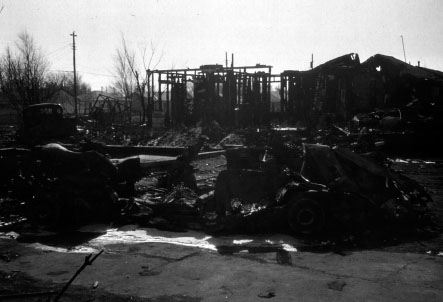
Burned-out car frames and houses on Piatt Street.
Kansas Firefighters' Museum
.
Because of the potential for such a disaster in the “Air Capital”ânicknamed because of the many aircraft corporations founded there in the late 1920s and early 1930sâall of the fire departments that responded were trained in unique rescue procedures involving military aircraft crash firefighting. Having been trained in these special types of hazards, they were efficient in extinguishing the fire in a timely manner. Despite an initial lack of communication among the departments concerning location and placement after arriving on scene (later criticized by Chief McGaughey), these intense training sessions, as McGaughey commented, “paid offâ¦knowing what to do and how to do it⦔
113
In the end, this miraculous effort of disaster containment was made possible because of the unparalleled, quick response of firemen from Wichita, Boeing and McConnell. The ability of the community to bind together and aid the emergency responders, however, was also a large factor in the success of the firefighting efforts. Everybody pitched in. Extinguishing a fire of that magnitude, that quickly, was a superhuman feat. Of course, it took equipment, proper training and one and a half million gallons of water, but the actions of the brave men and women who selflessly assisted the firemen saved many lives.
114
It was a collective community effort in an otherwise segregated community, something rarely seen in 1965.
6
THE KC-135
Peace Is Our Profession
âUSAF, Strategic Air Command Motto, 1946-1992
The rationale of military necessity has provided fodder to countless heated debates. And three days later, on January 19, 1965, the
Wichita Beacon
posed the inevitable question that lingers on to this day: “whether the plane should have been flying over a congested urban area when it was loaded with nearly [thirty-one thousand] gallons of highly volatile jet fuel.”
115
There is no simple answer.
The conception of airpower theory, the purpose of the KC-135 and the vision of an Italian artillerymanâa vision that was birthed before World War I and later matured under SAC following World War IIâprovides, to some degree, an insight into why Operation Lucky Number not only existed but was also necessary.
T
HE
I
TALIAN
He was laughed to scorn for several of his ideas. He was considered irrational, insubordinate, a charlatan, a caviler, a loon, a far-fetched dreamerâwho was eventually court-martialed for his criticisms of the Italian army, imprisoned, vindicated, released, promoted to general and then retired to write the world's first theory of air war in 1921:
The Command of the Air
.
116
He then became a visionary, the father of modern air warfare, a man who theorized the strategic use of the airplane within barely a decade after its invention. Although it was once considered preposterous to use an airplane as a strategic weapon in warfare, he knew better.
Giulio Douhet, the Italian general and great airpower theorist of the twentieth-century, said, “Victory smiles upon those who anticipate the changes in the character of war, not upon those who wait to adapt themselves after the changes occur.”
117
Douhet was of the belief that “airplanes, like warships and armies, should be massed against the decisive point” in order to defeat the enemy.
118
The only problem with this theory was that it had yet to be seen or tested, since the technology needed for some of Douhet's anachronistic theories did not exist. Nonetheless, Douhet, though highly criticized and considered controversial, successfully developed a doctrine for the strategic use of airpower in the 1920s that would soon revolutionize warfare.
119
J
ET
B
OMBERS
Twenty years later, while America was fully engaged in World War II, the use of strategic bombingâDouhet's “irrational” ideaâwas now being deployed. Posthumously, Douhet was vindicated, again. Following the strategic bombing campaigns on Germany and Japan in World War IIâwhich led to the economic breakdown of the Axis powers, the detonation of two atomic bombs and essentially ended the warâU.S. military leaders came to realize the need for planes with capabilities of flying greater distances to bomb the enemy and then return home. Jets needed to become efficient ordnance carriers in order to match the range and payload capacities of propeller planes.
120
This would soon be the case.
Created in 1946, SAC's mission was to “conduct long range offensive missions in any part of the world.”
121
With the beginning of the Cold War and the looming threat of a Soviet attack following World War II, the subsonic B-52 (Stratofortress) heavy bomber was the jet-powered strategic bomber military commanders were looking for. Becoming operational during the period of 1955 to 1962, the B-52 had a range of 10,000 to 12,500 miles and was fully capable of aerial refueling. It was adept at carrying multi-megaton free-fall bombs or two deadly “Hound Dog” missiles (earning their nickname from Elvis Presley's hit song) and could travel up to 600 miles per hour at fifty thousand feet.
122
It was the ultimate war machine.
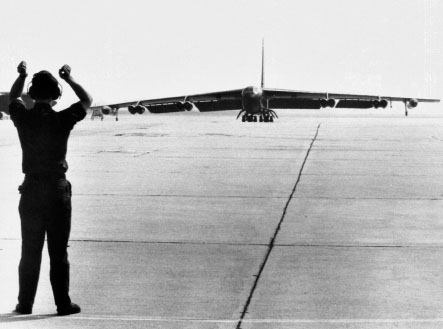
B-52 taxiing.
22
nd
ARW History Office
.
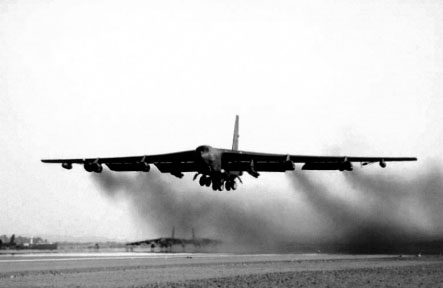
B-52 taking off.
22
nd
ARW History Office
.
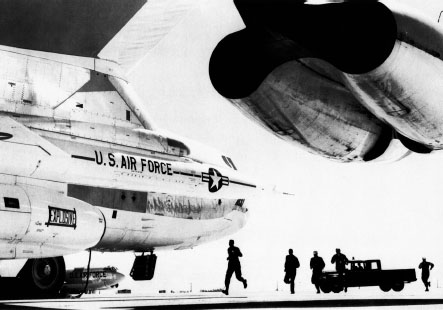
B-52 crew running “on alert.”
22
nd
ARW History Office
.
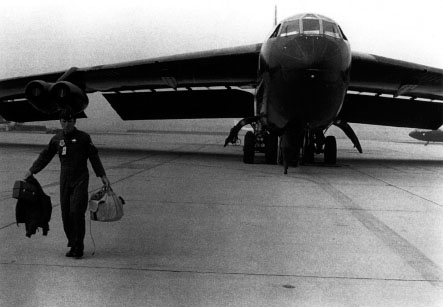
B-52 on ground.
22
nd
ARW History Office
.
During the 1960s, the B-52 made up a substantial portion of the U.S. military's strategic bomber force and was a proud display of American military prowess. “A B-52 can fly from the United States to the Soviet heartland with a 10,000-pound bomb load and return without refueling,” noted Jeremy J. Stone, an expert in foreign policy and former president of the Federation of American Scientists, in a 1964 article entitled “Bomber Disarmament.”
123
Accordingly, if the U.S. deterrence-oriented military policy failed and the Cold War developed into a hot war, Stone's assessment might have become a reality.
A N
EW
T
ANKER
Superior bombing capability required aerial refueling, and the B-52 needed a colossal tanker to replenish its fuel.
124
Originally, the air force had been using the KC-97 tanker to refuel its B-47s, Boeing's first jet bomber. But the propeller-powered KC-97 was slow and had a low operational altitude, which created multiple problems with the refueling operations. The faster, jet-powered B-52s had to lower their flaps and rear landing gear just to slow down enough to be refueled by the KC-97.
125
Eugene Rodgers, in his book
Flying High: The Story of Boeing and the Rise of the Jetliner Industry
, highlights the various problems that arose with the aerial refueling of jet bombers:
The most compelling need was for jet tankers. Flying together in a refueling operation was difficult for the jet B-47 and a propeller-driven tanker; there was a serious mismatch in speeds. The highest speed that the tanker could fly was not much more than the slowest speed that a B-47 could fly without losing lift. The situation would be even worse when the Air Force started flying bigger, faster B-52s in a few yearsâ¦the Air Force would soon see the necessity for hundreds of jet tankers
.
126
With the “Jet-Age” fully underway after World War II, there was an obvious need for a new jet tanker. Abandoning the more cumbersome and time-consuming procedures for aerial refueling, Brigadier Generals Clarence S. Irvine (SAC) and Mark E. Bradley (Air Materiel Command), along with Cliff Leisy (Boeing), developed a new method for aerial refueling called the “flying boom.”
127
The flying boom completely transformed in-flight refueling. The revolutionary new flying boom system was described by air force historian Walter J. Boyne in
Beyond the Wild Blue
as consisting of “a long telescoping transfer tube with two V-shaped control surfaces, called âruddervators.'”
128
The process for refueling, according to Boyne, meant that the refueling plane would fly, “above and in front of the receiver, which flew in close formation, permitting the boom operator to fly the boom into the receiver's receptacle.”
129
The flying boom allowed jet fuel to be transferred expeditiously because of its high pressure, greatly reducing refueling times. This would later become the standard method used throughout the air force in the 1960s.
